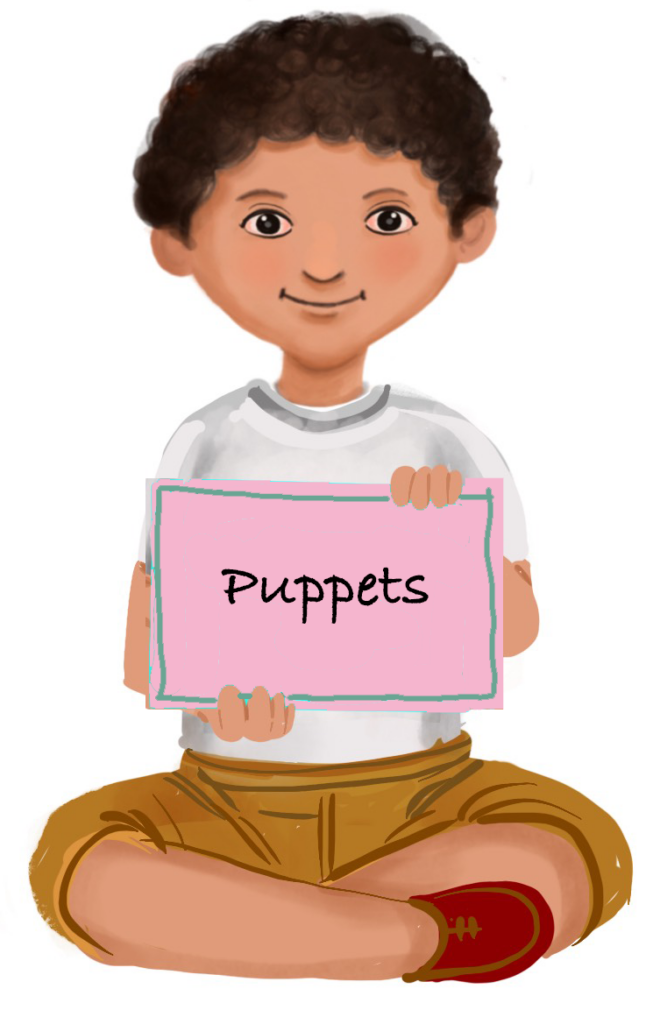
Parrot
 Objective
Objective
To guide teachers in creating a puppet of a parrot for story-telling and other educational purposes.
Estimated time to create the Parrot Puppet
30 to 45 Minutes
Materials required for creating Parrot Puppet
- Felt paper- Green colour for the face/body
- Red colour for the beak
- Googly eyes
- Glue drops or Fevicol
- Scissors
Preparation for activity
Keep the materials ready. If you are using hot glue instead of Fevicol, ensure that the hot glue is heated suitably and is ready for use.
Procedure
- Take a rectangular piece of green felt paper.
- To form a cylindrical shape, make about five slits along the middle section of the paper’s length, on both the long edges. The slits should be about one inch apart, with the middle slit slightly shorter than the others.
- Roll the sheet and join the shorter edges to form a cylinder. Secure the edges with glue.
- Overlap the slits at the top front of the cylinder and glue them one over the other. Repeat the same for the bottom side.
- Trim and remove any excess paper projecting from the back of the cylinder. Now the hollow face of the parrot is ready.
- Take a piece of red felt paper and cut out two triangular shapes, one bigger than the other.
- To make the upper beak, take the bigger triangle. Create a gentle curve by making small slits on both the sides, overlapping the edges slightly and gluing them together. This gives the beak a bent shape similar to that of a parrot. Attach it to the front of the face.
- Fold the smaller triangle into ‘V’ shape and attach it just below the upper beak to form the lower beak. Glue the sides of the upper and lower beak together to join them securely.
- Take two googly eyes and stick them above the beak, one on each side using small drops of glue. Ensure that both eyes are placed equidistantly and diagonally from the beak.
- For the finger pipe, roll a small strip of green paper into a tube that fits your forefinger (index finger) and glue the edge to secure it.
- Fix the pipe inside the hollow body using glue.
- Allow it to dry for a few minutes. The puppet is now ready.
- Insert your forefinger (index finger) into the pipe and move your finger up, down and sideways to demonstrate the movement of a parrot’s head.
Step by Step Pictures to create the puppet
Important Tips
- For this type of puppet, it is better to use thick chart paper to ensure durability and allow for repeated use.
- Wedding cards or book covers can be good alternatives to drawing sheets.
- Reference images from drawing books or the internet can be helpful while designing the puppet.
- While creating the puppet, try to replicate the character illustration from the children’s textbook. Once the puppet is ready, refer to it by the character’s name from the textbook. This helps children connect with the content and improves recall.
- The teacher should use the puppet at an appropriate time, perhaps while narrating the story in a funny and humorous way. Intentional mistakes can also be made to encourage children to correct them, making the session more interactive and engaging.
Precautions
Precautions to be taken while manipulating finger puppets:
- Always keep the puppet’s face directed towards the audience.
- The Puppet Master’s focus should remain on the puppet at all times.
- Only the puppet that is ‘speaking’ should be animated; all other puppets should remain still.
Troubleshooting:
- While making the paper pipe, ensure it matches the exact size of the finger you will be using. This helps to move the puppet properly.
- Use a cutter carefully to make clean, precise holes.
- The holes should match the size of your fingers. If the hole is too large, the puppet won’t stay upright on your finger. If the hole is too small, it will be difficult to insert your finger.
 Notes to the Teacher
Notes to the Teacher
Puppets can be effectively used in the classroom to help children understand and express emotions. They are also valuable tools for teaching rhymes, songs, stories and more.
In addition to enriching learning experiences, using puppets supports the development of motor skills such as hand-eye coordination. They also enhance communication and social skills, improve focus and concentration, and help reinforce concepts and values in an engaging way.
Using the Learning Teaching Material
The teacher can demonstrate a puppet show as an example. Students can then be encouraged to create their own puppets and present a puppet show in the classroom.
Video: How to use Learning Teaching Material
| Source and Attribution of images All images used in the above Assets and Aids are originally created. |
| This digital material has been developed by the Sri Sathya Sai Vidya Vahini Inclusive Education Project, a unit of Sri Sathya Sai Central Trust, Prasanthi Nilayam, as a collaborative offering in the service of our nation. |